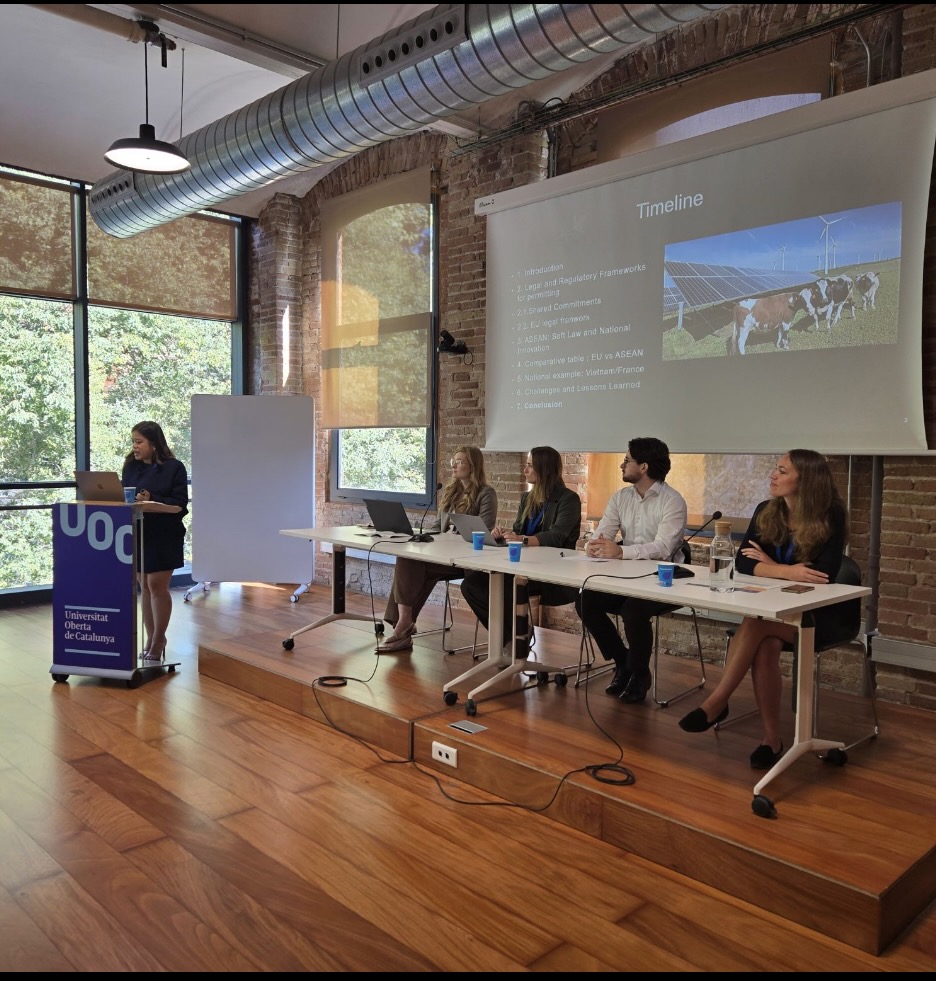
International Conference on the Crossroads of International Environmental Law: Paradoxes of energy transition and global inequalities, University of Catalunya y Barcelona, 3-4 september 2025
THE ROLE OF STATES IN BALANCING RENEWABLE ENERGY DEVELOPMENT AND BIODIVERSITY PROTECTION: THE CASE OF WIND ENERGY PERMITTING IN EUROPE AND ASEAN
✨ Kicking off September at the International Conference on the Crossroads of International Environmental Law: Paradoxes of energy transition and global inequalities, Barcelona, 3–4 September 2025.
Together, these contributions highlighted the complex legal tensions at the heart of the energy transition:
⚖️ Between large-scale infrastructure and community rights
🌱 Between renewable expansion and biodiversity protection
🌍 Between climate goals, extractive practices, and uneven global geographies
Speakers from diverse regions and disciplines underlined a shared reality: the pathway to a sustainable future requires balancing climate ambition, economic development, and environmental integrity.
The opening day also brought rich discussions on some of the most pressing global challenges:
⚡ The tensions of the energy transition
💼 The complex interplay of trade and investment
🌱 The urgent need to address environmental crime
✨ A big thank you to my fellow panelists Tina, Darjana, and Albert from
Panel 1 – Legal Tensions in the Energy Transition for such rich and stimulating discussions. Special thanks to our wonderful chair, Bettina, for guiding the debate with clarity and insight. 🙏
I was honored to present on how States balance renewable energy deployment ⚡ and biodiversity protection 🌱, through a comparative lens between the EU and ASEAN. This theme goes back to my beloved thesis topic: the global North–South divide in sustainable development law, a paradox that remains at the heart of the energy transition.
In line with the international commitments1, the European Union and ASEAN are putting effective and responsible sustainable development at the core of its policy design and legal framework to find legitimacy where its intervention is not necessarily obvious in the sector of energy and the protection of the biodiversity. This tension is particularly evident in the permitting processes for wind energy projects, which often intersect with strict environmental and species protection laws.
On one hand, in the European Union, wind energy has been a key pillar of climate policy. To achieve the EU's 2030 targets—at least 40% renewables in the energy mix—and ultimately climate neutrality by 2050, Member States are under pressure to expedite permitting procedures and facilitate the deployment of wind infrastructure. Simultaneously, the EU Biodiversity Strategy to 2030 underscores the need to halt biodiversity loss and integrate nature conservation into economic recovery and growth strategies. Both policy tracks are legally supported by directives, notably the Renewable Energy Directive (RED III), the Habitats Directive (92/43/EEC), and the Birds Directive (2009/147/EC).
On the other hand, in the ASEAN context, although regional environmental law is less binding, national governments are developing increasingly sophisticated permitting regimes for renewable energy. Vietnam, for example, has emerged as a regional leader in wind energy deployment, while also introducing environmental assessment procedures modeled in part on international standards. Similarly, the Philippines has adopted legal instruments that require Environmental Impact Assessments (EIAs) and public consultation for major infrastructure projects, including wind farms.
Activities and projects such as wind powered project that are vital for the society, or mitigate climate change, could harm protected species and their habitats causing alteration, destruction or birds scaring. Besides, it likely to have an impact on national strategy on conservation of species of wild fauna and flora.
The main issue is how the EU and Asean governments balance both sustainable development objectives which are the growth of renewable energy and the protection of the species.
This paper examines the legal and regulatory frameworks governing wind energy permitting in Europe and Asean. It explores how States in both Europe and Southeast Asia reconcile the urgent need for renewable energy expansion—particularly wind power—with the legalobligation to preserve species and habitats.
Through a comparative legal analysis, it examines the permitting frameworks applicable to wind energy projects in the EU and ASEAN regions, with a particular focus on France and selected Asean jurisdictions. These case studies illuminate the challenges faced by States as they attempt to conciliate between different legal franmework: one promoting energy transition and the other ensuring environmental integrity.
By highlighting on the tensions and trade-offs embedded in the permit-granting process, the paper emphasizes the evolving role of States—not only as regulators and facilitators but also as mediators between competing legal priorities in the pursuit of a just and ecologically coherent energy transition.
The comparative approach highlights divergent institutional capacities, legal traditions, and levels of regional integration, offering valuable insights into the conditions under which legal coherence and ecological responsibility can be achieved.
#ClimateJustice #EnergyTransition #Biodiversity #GlobalNorthSouth #InternationalLaw #Barcelona2025
VAI TRÒ CỦA NHÀ NƯỚC TRONG VIỆC CÂN BẰNG PHÁT TRIỂN NĂNG LƯỢNG TÁI TẠO VÀ BẢO TỒN ĐA DẠNG SINH HỌC: TRƯỜNG HỢP CẤP PHÉP DỰ ÁN ĐIỆN GIÓ Ở CHÂU ÂU VÀ ASEAN
✨ Khởi động tháng 9 tại Hội nghị Quốc tế về Ngã ba của Luật Môi trường Quốc tế: Những nghịch lý của chuyển dịch năng lượng và bất bình đẳng toàn cầu, Barcelona, 3–4 tháng 9 năm 2025.
Các tham luận đã cùng nhau làm nổi bật những căng thẳng pháp lý phức tạp trong quá trình chuyển dịch năng lượng:
⚖️ Giữa hạ tầng quy mô lớn và quyền lợi cộng đồng
🌱 Giữa mở rộng năng lượng tái tạo và bảo tồn đa dạng sinh học
🌍 Giữa mục tiêu khí hậu, khai thác tài nguyên và sự chênh lệch địa lý toàn cầu
Các diễn giả đến từ nhiều khu vực và lĩnh vực khác nhau đã nhấn mạnh một thực tế: con đường đến một tương lai bền vững đòi hỏi phải cân bằng giữa tham vọng khí hậu, phát triển kinh tế và toàn vẹn môi trường.
Tôi rất vinh dự được trình bày về vai trò của Nhà nước trong việc cân bằng phát triển năng lượng tái tạo ⚡ và bảo tồn đa dạng sinh học 🌱, với góc nhìn so sánh giữa EU và ASEAN. Chủ đề này gắn liền với luận án tiến sĩ yêu thích của tôi: sự phân chia Bắc – Nam toàn cầu trong luật phát triển bền vững, một nghịch lý vẫn nằm ở trung tâm của quá trình chuyển dịch năng lượng.
Ngày khai mạc cũng mang đến nhiều thảo luận sâu sắc về những thách thức toàn cầu cấp bách:
⚡ Căng thẳng trong quá trình chuyển dịch năng lượng
💼 Sự đan xen phức tạp giữa thương mại và đầu tư
🌱 Nhu cầu cấp thiết trong việc xử lý tội phạm môi trường
✨ Xin gửi lời cảm ơn chân thành đến các đồng nghiệp Tina, Darjana và Albert trong Panel 1 – Legal Tensions in the Energy Transition vì những trao đổi phong phú và đầy cảm hứng. Đặc biệt cảm ơn Bettina, người đã điều phối phiên thảo luận với sự sáng suốt và rõ ràng. 🙏
#LuậtKhíHậu #ChuyểnDịchNăngLượng #ĐaDạngSinhHọc #BắcNamToànCầu #LuậtQuốcTế #Barcelona2025


